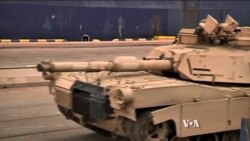Top U.S. officials are warning of the dangers of a growing gap between U.S. and European defense spending at a time of heightened tensions with Russia over Ukraine. The warnings come as U.S. tanks and warships are being deployed in Europe for ongoing NATO training operations.
Rolling off the Liberty Promise cargo ship and onto Riga harbor, about 400 armored vehicles were unloaded in Latvia’s capital this week in a show of U.S. military muscle. On the dockside, U.S. Army Major General John O’Connor said it is a show of solidarity.
“We can deliver combat power for our allies any time, anywhere needed and our message to the Latvian people, U.S. allies and partner nations is that the U.S. Army Europe can and will provide prompt support as needed from the air, from the sea and from the land," he said.
NATO has repeatedly warned of the increased threat from Russia following its forceful takeover of Crimea a year ago, and its continued interference in eastern Ukraine.
At the NATO summit in Wales last year, members signed a commitment to spend a minimum of two percent of GDP on defense. But European Leadership Network chief researcher Lukasz Kulesa said his group's analysis of 14 NATO members suggests that besides the United States, only one, Estonia, would meet that target.
“A number of countries are actually doing the opposite of what they pledged in Wales, which means that they are decreasing military spending,” he said.
Britain, traditionally the United States’ strongest ally in NATO, is among those predicted to fall short of the two percent target. That could impact Britain’s role in coalition operations, said analyst Ben Barry of the International Institute for Strategic Studies.
“The British army does not have as many forces to send to a multinational operation as it once did," he said. "In addition of course, the U.S. army itself has got smaller. So you could argue that it becomes even more dependent on multinational partners to build up an effective fighting force in a coalition operation.”
The United States’ contribution to NATO has steadily increased, according to Lukasz Kulesa.
“It is more than 70 percent, which is 20 percent higher than during the Cold War era," said Kulesa. "And of course it is not a healthy situation because it creates in some countries an assumption that they do not really need to try.”
The trend of static or falling defense spending is reversed in Estonia, one of the states on the frontline of the West’s tensions with Russia. Kulesa said Estonian defense spending is on course to hit 2.5 percent of GDP.
“It also has a powerful political message that the countries which are most concerned about their security are actually putting the money in the right places,” he said.
Russia has conducted regular military exercises close to Ukraine’s border, and NATO commanders warn Moscow is investing heavily in modernizing its armed forces.
Military experts have long agreed on the technological superiority of U.S. and Western military hardware. The gap may be closing, but still exists, said Barry.
“There are some areas of Russian capability that I would think the United States and NATO respect — for example their nuclear capability, their ability to produce an effective layered air defense," he said. "Their tanks and armored vehicles are perhaps not up to the same standard as the best Western tanks and armored vehicles such as the Leopard 2A7 or the M1 Abrams.”
Such hardware is now being deployed across Europe in a show of force. Further south in the Black Sea, U.S. warships are leading NATO maneuvers off Bulgaria.
With Russia building its forces, U.S. diplomats say NATO allies in Europe should recognize the scale of the threat.











